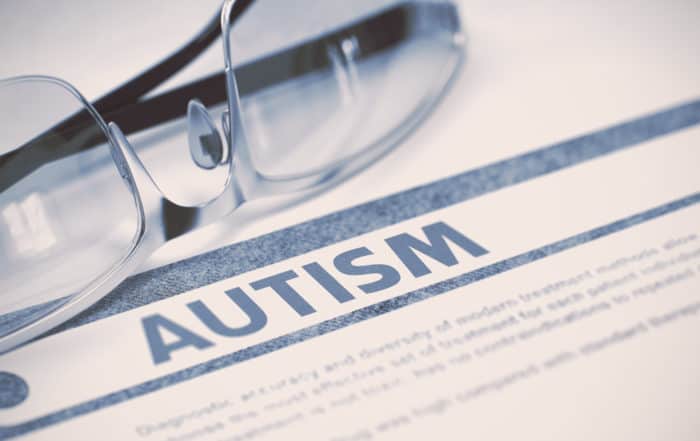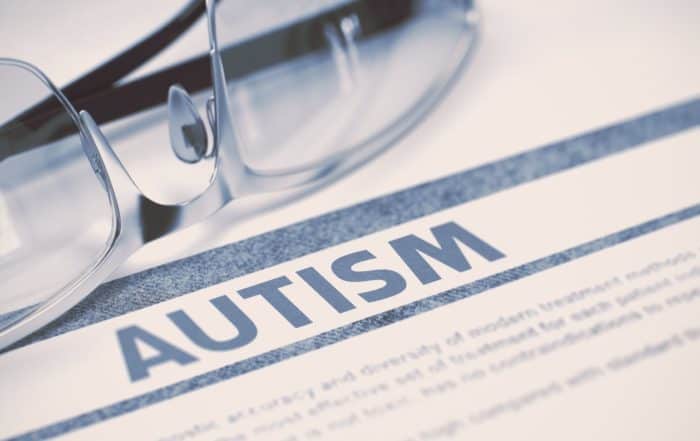Dr. Waizbard-Bartov discusses changes in autism symptoms across childhood. She outlines the Autism Phenome Project and study methods for her recent work. The speaker presents findings on the frequency, patterns, and predictors of symptom severity changes across childhood periods in autism. Waizbard-Bartov touches on the intersection of autism symptom severity, assigned sex, and environmental factors. She summarizes presentation findings and considers pathways of future research before the Q&A.
In this webinar:
1:09 – What is autism
5:00 – Social communication and RRB
12:06 – Autism Phenome Project
16:15 – Study methods
20:15 – Changes in autism symptom severity across childhood
24:30 – Variations in patterns of symptom change
28:05 – Predictors of changes in severity across childhood
30:25 – Sex differences
35:40 – Adaptive function
37:44 – Parental characteristics
39:10 – Co-occurring mental health conditions
What is autism?
Waizbard-Bartov describes autism as a neurodevelopmental condition broadly defined by difficulties with social communication and restrictive, repetitive behaviors (RRB) (1:09). For an autism assessment, social communication differences are subcategorized into social-emotional behavior, atypical nonverbal social behavior, and difficulty creating and maintaining relationships (2:15). RRBs are also subcategorized into stereotyped repetitive speech or actions, excessive adherence to non-functional routines, restricted/fixated interests, and atypical sensory behaviors (4:19). The speaker draws on her time working with preschoolers to illustrate how core characteristics/symptoms of autism range in presentation and severity across individuals and time (8:00).
Study methods
The presenter outlines the Autism Phenome Project (APP), a longitudinal study of nearly 700 autistic and non-autistic children across five time points from early childhood to early adulthood (12:06). At each time point, the ongoing study assesses blood, MRI, language development, memory and attention, co-occurring conditions, and parental perspectives (14:20). Waizbard-Bartov describes her recent work on autism symptom trajectories across early (ages 3 – 6) and middle childhood (ages 6 – 11.5) (11:25). Her team used APP data for 183 autistic children (30% female-presenting) at three times points: between ages two and three and a half (2 – 3.5 yrs), between ages four and six (4 – 6 yrs), and again between ages nine and twelve (9 – 12 yrs) (16:15). Researchers used the calibrated severity scores from the Autism Diagnostic Observation Schedule (ADOS) to track symptom severity across time and domains (17:50).
Q1: How common is change in autism symptom severity across childhood?
Researchers divided children into three groups based on observed changes in symptom severity across the first two time points (early childhood; ages 3 – 6). Of these, 54% remained stable, 29% significantly decreased, and 17% increased dramatically in symptom severity across early childhood (20:15). Correlations between behaviors and brain development were also found, where children with increased severity had slower white matter development compared to those with decreased symptom severity (21:43). When assessments were extended to the third time point (middle childhood; around age 11.5), the same three groups were identified, where 49% remained stable, 27% experienced a consistent decrease, and 24% experienced a consistent increase in symptom severity (22:55). Waizbard-Bartov reiterates that about half of children in the study demonstrated changes in severity across early and middle childhood, suggesting that such changes may be expected in autism (24:00).
Q2: Do patterns of change vary across periods of childhood?
To understand patterns of symptom change across time, the presenter and her team compared early childhood severity changes to those of middle childhood (third time point). Results showed increases in symptom severity are equally as likely to occur during early and middle childhood, while decreases in severity are significantly more likely to occur in early childhood only (24:30). Researchers also found that more than 60% of the sample showed different patterns of change across childhood periods (i.e., decreased in early childhood and stable or increasing during middle childhood) (25:35). Waizbard-Bartov summarizes these findings, asserting that patterns of severity change across periods of childhood in autism (27:15).
Q3: What predicts directional changes in symptoms across childhood?
To assess predictors of symptom severity changes in autism, Waizbard-Bartov and her team assessed related variables:
Cognitive ability/IQ
Results showed that children with decreased severity in early childhood had a higher IQ at the first two time points and exhibited IQ gains over time (28:45). Comparatively, those with increased severity had lower IQ at both time points that remained stable across time (29:30). The speaker asserts that these findings suggest a strong association between cognitive abilities and symptom severity during early development.
Sex differences
Researchers found in female-presenting participants, symptom severity is likely to decrease or remain stable. However, for male-presenting participants, increases and decreases in severity are equally likely to occur (30:25). Further, calibrated severity scores revealed that female-presenting individuals show significant severity decreases in total symptoms and, more specifically, in RRB, especially during middle school. Conversely, male-presenting individuals show stable total symptom and RRB scores across childhood (31:15). The presenter discusses sex-compared changes across ADOS items, highlighting the stark trajectory differences between sex groups (33:15).
Adaptive function
Adaptive functioning is meaningful for everyday life, and all three groups had the same score at age one. However, by age six, those experiencing decreases in severity had significantly higher adaptive functioning than those with increasing severity (35:40). The presenter explains how those with increasing severity did not necessarily lose adaptive function skills but that their rate of progress steadily slowed over time (36:40).
Parental characteristics
Waizbard-Bartov and her team also found that fathers and mothers of children with decreasing severity were generally older and more educated. Contrastingly, parents of children with increasing severity were younger and less educated. The speaker notes the intersectionality of education and socioeconomic status and its impact on resource accessibility and self-advocacy (37:44).
Co-occurring mental health conditions
Results showed a significant correlation between aspects of mental health and autism symptom domains (39:10). For example, 21% of participants had significant increases in both the severity of social communication issues and anxiety as they entered elementary school. ADHD levels also rose across middle school, and by age eleven, 84% of participants met the clinical requirements for an anxiety disorder (41:25). In female-presenting participants, improvements in RRB overtime ran parallel to increases in anxiety, where 94% had clinical anxiety disorders by age eleven (44:26). Waizbard-Bartov and her team found no evidence that initial symptom severity can predict changes across childhood, meaning everyone has the same potential for change (45:05). The presenter summarizes the findings for question three, noting that severity changes are correlated with assigned sex, IQ, adaptive functioning, parental characteristics, and mental health conditions (46:45).
- Trajectories of Autism Symptom Severity Change During Early Childhood (Waizbard-Bartov et al., 2021)
- Identifying autism symptom severity trajectories across childhood (Waizbard-Bartov et al., 2022)
- Changes in the severity of autism symptom domains are related to mental health challenges during middle childhood (Waizbard-Bartov et al., 2023)
Conclusion
Waizbard-Bartov summarizes research findings, underscoring that the severity of autism symptoms can change substantially across childhood periods and that patterns of change are not linear. She highlights that a child’s characteristics and environment can predict directional changes and that children have the potential for different severity trajectories regardless of their initial levels (47:55).
She outlines future research directions, including how severity is affected during adolescence and how interactions between symptom severity and other characteristics play out over time (49:15). The presenter highlights current research around the impact of sex on symptom severity, underscoring the potential effects of camouflaging specific to female-presenting individuals (51:10). The speaker provides thanks and acknowledgments before the Q&A (53:25).
Originally published on May 15, 2024
The speaker:
 Dr. Einat Waizbard-Bartov is a post-doctoral researcher working with Dr. Ilan Dinstein at the Azrieli National Centre for Autism and Neurodevelopment Research at Ben-Gurion University, Israel. Dr. Waizbard-Bartov completed her doctoral studies at the University of California, Davis, working with Dr. David Amaral at the UC Davis MIND Institute’s Autism Phenome Project. She is also a licensed clinical psychologist trained in autism assessment and play-based and cognitive-behavioral therapies with children. Dr. Waizbard-Bartov is especially interested in assessment and measurement of autism symptoms, developmental trajectories across the life span and how these translate into individual needs, and the female autism phenotype.
Dr. Einat Waizbard-Bartov is a post-doctoral researcher working with Dr. Ilan Dinstein at the Azrieli National Centre for Autism and Neurodevelopment Research at Ben-Gurion University, Israel. Dr. Waizbard-Bartov completed her doctoral studies at the University of California, Davis, working with Dr. David Amaral at the UC Davis MIND Institute’s Autism Phenome Project. She is also a licensed clinical psychologist trained in autism assessment and play-based and cognitive-behavioral therapies with children. Dr. Waizbard-Bartov is especially interested in assessment and measurement of autism symptoms, developmental trajectories across the life span and how these translate into individual needs, and the female autism phenotype.
Take the knowledge quiz
Can’t see the quiz below? Take it online HERE
How Age – and Age of Diagnosis – Affect Quality of Life
Dr. Gray Atherton discusses the critical role of age and age of diagnosis in shaping the quality of life for autistic individuals. She provides a brief history of autism understanding and considers
Behavioral Support – Beyond Early Intervention
Due to technical difficulties, playback has been delayed. Check back later. About the speaker: Dr. Melissa Olive’s brother, Mac, is the foundation of her mission. In her early teens Missy,
ABCs of Behavioral Support in 2021
Melissa Olive, Ph.D., BCBA-D describes the components of a quality behavioral support program. She discusses controversial characteristics of applied behavioral analysis (ABA) and outlines current ABA best practices. Olive summarizes the "ABC view"
Editorial – Diagnosis and Screening for Autism: Past, Present, and Future
While the diagnosis of some syndromes is fairly straightforward, diagnosing autism spectrum disorders (ASD) has been and continues to be a challenge. In this editorial, I review the progress we have made
Assessing and Treating Challenging Behavior in Individuals with Autism
Lauren Moskowitz, Ph.D., discusses the complex aspects of challenging behaviors and the importance of conducting a thorough functional behavioral analysis to create effective treatment plans. The talk underscores the importance of recognizing challenging behaviors
ABA in Schools – Quality Education Programs in Schools
Presented by Ron Leaf, PhD It's Time for School: Building Quality Education Programs for Students with ASD Presented by Ron Leaf, PhD at the Fall 2012 Autism Research Institute Conference School Districts across







